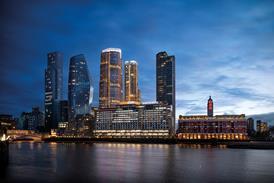The Museum in Docklands is housed in 10 200 m2 of the Grade 1-listed Warehouse No 1 at West India Quay. Sited slightly north of the main Canary Wharf development, the Quay is already established as an entertainment centre for the area, with a multi-screen cinema and several bars lining the dockside.
The building is one of two surviving major Georgian dockhouses in British ports. It dates from 1802, with extra floors added in 1827 to attract the East India tea trade. It has lain empty since containerisation and competition forced the city's port upstream.
Now traditional museum displays and multimedia technologies combine to tell the story of life along the Thames. The exhibits are arranged chronologically in 13 galleries over the building's five storeys. Also included are a temporary gallery, archive, shop, restaurant and a 150-seat auditorium.
The planned spring opening follows an agreement by the governors of the Museum of London to join the Museum in Docklands' board of trustees and jointly govern the new museum.
Serving time
HBG Construction was appointed main contractor for the scheme in a contract worth £7.4 million. Fulcrum Consulting won the contract to design the shell and core m&e engineering services.
A key element of the services was a government-sponsored energy study carried out in the early design stages. The study gave Fulcrum the opportunity to maximise the building's potential to provide passive environmental control. Dave Selvage, Fulcrum project engineer confirms: "The Museums & Galleries Commission push for this quite strongly. The strategy is to reduce reliance on mechanical systems and save museums money through lower running costs."
Passive measures such as natural ventilation would not fulfil conservation needs, but one of the main concepts of the services is to use the building's solid brick walls as an energy store in a night-time ventilation scheme. The bricks cool during the night, and by recovering this energy it is possible to reduce the load on the chillers during the day. Such methods helped to reduce the engineering, hence the capital and running costs.
All of the galleries have the same basic servicing. Local air handling units for heating, cooling and humidity control are fed via ducts from one of two packaged, rooftop plantrooms, which handle air supply and extract and include a heat recovery system. "The energy study was the driving force behind using ducted ventilation to deliver cooling rather than a pipe-based system, as it could reduce the load," explains Selvage. Carbon dioxide sensing is built in so that the fresh air supply can be varied to suit levels of occupancy; during low occupancy more air will be recycled.
"To keep the running costs down, we have a floating setpoint," adds Selvage. "This is 26°C in summer rather than the 22/23°C it would be with a standard air conditioning system." This was done to minimise the chiller size – by capping temperatures rather than maintaining them permanently at lower levels the same effect can be achieved with less mechanical plant.
The energy study again provided the evidence needed to apply this technique. "It is very easy to say to a client 'you get rooms at 22°C in summer' and they have to pay for all of that extra cooling. But by showing that it is possible to have higher temperatures in a building with a transient occupancy, savings can be made on cooling loads and running costs."
The temporary exhibition and archive areas had to be treated differently. The archive area is on a close control system, with temperature and humidity control; and the temporary space is serviced on a separate system – a standard policy when borrowing artwork.
The majority of the ductwork in the building is of the flat, oval type and is exposed. "There was no point trying to hide it, so instead we made a feature of it," says Selvage. The existing ceilings in many areas are low and by allowing the services to be seen it meant the building's features could be maintained.
The service runs are concentrated along the main beams running through the structure. In visually sensitive areas, carefully planned lighting directs the visitors' eyes towards the exhibits and away from the rafter-height services. These are centrally operated from a control room on the first floor.
The listed building status influenced the selection of plant and the methods of installation. The only prefabricated items used were the plantrooms. Selvage explains: "This decision was driven by the fact that it is a listed building. The ductwork, etc has to be modified and installed on site to cater for the odd shapes and beams that need to be taken account of during installation."
Its most important influence, suggests Selvage, is the size of the plant that could be accommodated without affecting the structure: "There were physical restrictions on the sizes of the plant and ductwork. By using prepackaged rooftop units we can get a lot more plant and capacity than if it was installed in the traditional manner on site," he explains. "This was a major factor in going for them – to get the capacity we needed."
Fulcrum was in close contact with the exhibition designer Haley Sharpe Associates from an early stage to ensure that the services installed would provide sufficient capacity for the final displays. "It was mainly the electrical services that they needed to interface with. We agreed with them during the design phase to ensure they had enough capacity and in the right places," explains Selvage.
The main electrical plantroom is in the basement. From here, busbars feed vertically through the building in two main risers – one to each plantroom. From the risers, electrical contractor Mitie Eastern installed three-compartment trunking: one compartment is filled with the main power supply cabling, the others are used for the exhibit fit-out supplies.
The trunking is set up on a grid system, duplicated on each floor. "In plan form it looks like an H shape with two horizontal bars," explains Selvage. Power can be tapped into at any point on the system ensuring that as visitors navigate their way through the museum, they need never be far from an interactive display.
Prices
Shell & core conversion: £8.5 millionFit-out: £5.5 million
Source
Electrical and Mechanical Contractor
Credits
Client Museum of London Project manager Gardiner Theobald Architect Purcell Miller Tritton & Partners M&E consulting engineer Fulcrum Consulting Lighting designer Fulcrum Consulting Main contractor HBG Construction M&E contractor Mitie Eastern Quantity surveyor Franklin & Andrews Museum design Haley Sharpe Associates Fit-out contractor C-Beck AHUs PM Luft, Mercury Climatic Boilers Hamworthy Chillers Mercury Climatic Extract fans Roof Units, Vent Axia, Mercury Climatic Fan coil units Lennox Diffusers and grilles Gilberts Flues Hamworthy Humidifiers J&S Humidifiers Pumps and pressurisation Holden & Brooke Radiators Barlo Water heaters IMI Rycroft BMS Trend - ECO Controls CCTV Midnight Security Switchgear Merlin Gerin Lifts Porn and Dunwoody Disabled hoists Landmark Lifts Luminaires Philips, Thorn, Trilux, Coughtree, Zumtobel, Design Plan, Bega, Whitecroft, CLS, Nulite, Concord:marlin, Philip Payne






















No comments yet